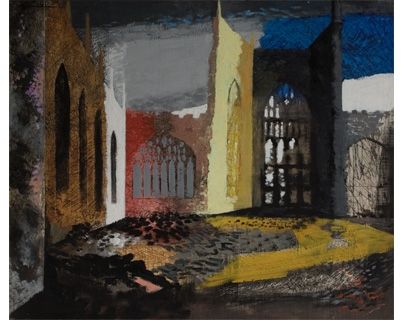An interview with the curator of the Mead Gallery’s John Piper exhibition
An exhibition of John Piper’s work is at the Mead Gallery in the Warwick Arts Centre until 21 June. Joseph Bullock talks to Fiona Venables, co-curator of the exhibition.
More than any other British artist of the last century, Piper’s work seems intrinsically linked to a sense of place. Why was this important?
From a very early age, basically his teens, Piper was interested in walking in the environment around his home in Surrey. He sketched and had an interest in the natural world, also in monuments and churches. Those interests really predated him becoming an artist. He took on, as many artists did around the 1930s, much of the language around modernism coming through from continental Europe, but he retained a sense of national identity. He didn’t want to use abstraction as a generic form; he would appropriate language to explore the specificities of place. So, you see in the early works (‘Houses in Surrey’, for example) that he is exploring a kind of primitivism such as the likes of Henri Rousseau. There is still a sense of season to this work, a time of day, but also of the specific architecture.
And depth?
Yes… in one of the works he uses sand to give a kind of nautical feel and colour, as well as to represent the physical granularity of sand embedded in paint.
He sketched and had an interest in the natural world, also in monuments and churches
Piper’s paintings are often marked by a sort of documentation as well. Why do you think he was drawn to this?
He was asked by Sir Kenneth Clark to be part of the Recording Britain scheme before the Second World War broke out, and that very quickly changed into him being an official war artist in 1940. He used the opportunity of being an official war artist and persuaded them to allow him to look at what was happening to monuments around Britain. He was sent to Coventry on the 15 November, the day after the Blitz. He was sent to work, but he used this to pursue something he was already interested in.
Would it be fair to say that the worlds of traditional architecture and his modernist influences were quite distinct?
No. I think all the art is linked to the specificity of place, and he looked back to medieval monuments and others to identify place, but also the skills that went into that [church-building, masonry, stain glass window making]. He chose to show his abstract paintings next to stain glass window studies. He said that he learnt everything he knew about colour from stain glass windows in churches and didn’t see a difference between abstraction and how planes of colour and light are used to underpin these ideas.
Piper was such an interesting artist in terms of Coventry: he came after the Blitz, but also 15 years later upon the opening of the new Cathedral
He found consistency in these ideas, but did he have an equally consistent reputation throughout his long career?
No. He became most well known in the 1940s, and he was subsequently known as a landscape painter heading into the early 1950s. Through the mid-50s, he had lost some of the cachet of the young artist. Despite this, he still received high-profile commissions, even including textile designs and stained-glass works. The exhibition shows him experimenting in all the forms he knew.
Did Picasso have the most pervading influence on Piper’s work?
I wouldn’t say that necessarily. As far as I’m aware, he never met Picasso. He went to Paris in the 1930s and met Alexander Calder, as well as Léger. He was certainly influenced by Picasso, and you can see this in his sketches. In many ways, I would consider his personal life, particularly his wife Myfanwy Evans, as his most important influence. We can’t really say who or what was the biggest influence on him: they all come together.
To close: the Mead Gallery is obviously an easy place for students to view quality artworks. What were the main reasons for choosing this artist?
Well, it was an opportunity that arose when we were approached by Tate Liverpool, who were planning to show Piper’s work for the anniversary of Liverpool Cathedral. For us, it wasn’t just a matter of thinking about the student population, but also about Coventry and working towards the City of Culture. Piper was such an interesting artist in terms of Coventry: he came after the Blitz, but also 15 years later upon the opening of the new Cathedral – huge moments in terms of Coventry’s history. Culture within Coventry isn’t acknowledged to be as significant as it actually is. If you look at the art in the Cathedral, it’s incredibly impressive and really shows a foresight and a commitment to artwork at the time. It has an idea of art saying something about the city, as well as the regeneration, with ideas of forgiveness and reconciliation through art, but linked to a religious environment. This, as well as thinking about an artist who explored the past and the future, was what really came together for the exhibition.

Comments